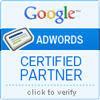With the many updates that Google has recently posted for the Certification program, we thought we would give you a little insight into what these changes entail and what the process is to become Google Certified. Now, instead of learning and taking exams through the Google Certification Program (GCP); users and companies will now have to create/transfer an account to the new Google Partners program.
• As of September 30, 2013, all access to your GCP account will be read-only information.
• A Google Partners account will be required in order to take exams to become certified.
• Exams will no longer cost $50.00 USD. All exams and certifications taken via Google Partners will now be free!
• Your previous exam history and certification status will transfer from GCP to Google Partners if you join using the same Google account.
• Certifications earned through GCP will remain valid through the expiration date.
Google Exams
To become Google certified, you must pass at least 2 exams; first the Advertising Fundamentals, then you can choose between either the Advanced Search or Advanced Display exams.
Advertising Fundamentals
In order to pass this exam, you need to have a passing score of at least 85%. You will be given 90 questions that must be completed within 120 minutes. Study material for this exam contains 11 lessons that can be found on the Google Partners site: Advertising Fundamentals Lessons
While the Fundamentals exam covers the basic aspects of Adwords, it is highly recommended that you study all 11 lessons.
Once passed, this exam is valid for 2 years.
Advanced Search
If you pass the Advertising Fundamentals exam, you can then choose between the Advanced Search exam and the Advanced Display exam.
The Advanced Search exam requires you to have a passing score of at least 80%. You will be asked 99 questions over 120 minutes. The study material contains 9 lessons that you should study explicitly. This is no easy exam. The questions are created to challenge even the most experienced Adwords users, and require you to answer with the best practices…not necessarily the methods that you as an individual apply. The study material can be found at: Advanced Search Lessons
Once passed, this exam will be valid for 1 year.
Advanced Display
If you choose to become certified specializing in the Display Network, then you should choose the Advanced Display exam. This exam requires a 70% passing score and will ask you 90 questions over 120 minutes. There are 4 lessons in the study guide: Advanced Display Lessons and once again, it is highly recommended that you cover all of the lessons while preparing to take this exam.
Once passed, this exam will be valid for 1 year.
Once you pass the 2 exams, your certification status will be updated on Google Partners (and your affiliated company) within 24-48 hours.
Failed an exam? Not to worry, they are free to take but you will have to wait 7 days to retake a failed exam.

